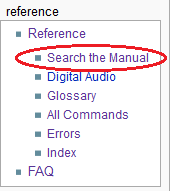

To run this script, you have to install and use the SharePoint Online Management Shell. This script in this article creates a text file that contains a list of all OneDrive sites. To collect a list of the URLs for the OneDrive sites in your organization, see Create a list of all OneDrive locations in your organization. For more information, see Partially indexed items in eDiscovery. Partially indexed items from SharePoint and OneDrive aren't included in the estimated search results.
#Searchgui reference code#
If you have a search query that contains keywords for non-English characters (such as Chinese characters), you can click Query language-country/region and select a language-country culture code value for the search. For more information about the unsupported characters that are checked, see Check your Content Search query for errors. Unsupported characters are often hidden and typically cause a search error or return unintended results. When you run a content search, Microsoft 365 automatically checks your search query for unsupported characters and for Boolean operators that may not be capitalized. Here's an example of the search query (displayed in the Details pane) that results when using the keyword list and a condition. This indicates that the keywords are connected to the conditions with a logical operator similar in functionality to the AND operator. Similarly, if your search query includes conditions, the keywords and the conditions are separated by the text (c:c). This indicates that the keywords are connected by a logical operator similar in functionality to the OR operator. In the search query that's displayed under Query in the details pane, the keywords are separated by the text (c:s). Each line from the Excel or text file is pasted into separate row in the keyword list.Īfter you create a query using the keyword list, it's a good idea to verify the search query syntax to make the search query is what you intended. Then, click the first row in the keyword list and paste your list. To do this, you have to select the Show keyword list check box. You can also prepare a list of keywords or keyword phrases in an Excel file or a plain text file, and then copy and paste your list into the keyword list.
#Searchgui reference how to#
Here are incorrect and correct examples of how to add a list of keywords. If you paste a list of keywords in the keyword box or press the Enter key after typing a keyword, they won't be connected by the OR operator. You have to select the Show keyword list checkbox and then type each keyword in a separate row to create a search query where the keywords (or keyword phrases) in each row are connected by the OR operator. Keep the following things in mind when using the keyword list to create a search query. Building a search queryįor detailed information about creating a search query, using Boolean search operators and search conditions, and searching for sensitive information types and content shared with users outside your organization, see Keyword queries and search conditions for Content Search. Content search limitsįor a description of the limits that are applied to Content searches, see Limits for Content search. This article describes features and functionality of Content search. For more information about Microsoft Purview, see the blog announcement. Using this feature regularly is not recommended, as it doubles the time required to perform a search and the use of reversed searches for validation has no general statistical value."īut to validate methods within PeptideShaker, I need an FDR, the only question is how the decoy interaction of SearchGUI, PeptideShaker interacts with the built-in decoy (if available) for any of the methods.Microsoft 365 compliance is now called Microsoft Purview and the solutions within the compliance area have been rebranded. The tag ":reversed" is added to the protein description, so that peptides corresponding to reversed sequences can be distinguished in the output. When the value of this parameter is yes, the protein sequences are first searched normally and then reversed in memory and searched again.

However, to make comparisons possible, X! Tandem has a protein sequence reverse method built in. The statistical analysis done by X! Tandem makes this type of crude estimate unnecessary. "By comparing the scores produced by this "decoy" search and the normal search, it is possible to very crudely estimate whether a result is potentially a false positive.


 0 kommentar(er)
0 kommentar(er)
